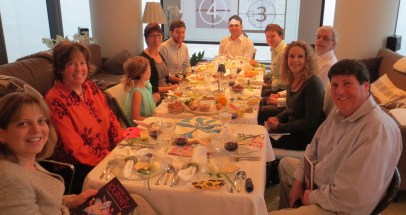“In every generation, each person must see themselves as if they went out of Egypt.”
This is my favorite line in the Haggadah.
In the Moss Haggadah, an illuminated text created by the artist David Moss, the page with this text depicts Jews from many different generations and places—Jews from ancient Middle Eastern countries, medieval European countries, colonial America, and so on. And in between each picture is a small mirror, so that when you look at the page, you see yourself along with all those Jews of different generations.
This year, when I look a the Moss Haggadah, I will see the faces of my maternal great-grandparents who came to the United States fleeing persecution in Czarist Russia in the 1890’s, and my paternal grandparents, who fled Nazi Germany in 1939. I’ll see my mother’s parents looking like folks straight out of a Sholom Aleichem play; I’ll see my dad’s father, age 7, in his lederhosen. I will add their faces that page of the Haggadah in my mind’s eye.
They told desperate stories to their families of their harrowing escapes, the laws they bent and broke to get out from under the tyranny of their native lands, and stories of the pride they felt in making it to America as refugees, as asylees. I will see I will see my maternal grandparents as they struggled to adapt to life in the United States, to learn English, to learn a new culture. I’ll see in the Moss Haggadah an image of my father’s parents as they spoke with tears in their eyes of all the family they left behind.
And then I will see– there on the pages of the story of our exodus from Egypt, the story of the miracles it took to free us—I’ll see those mirrors on the page. I will see myself—not as a refugee, but as a witness.
And I will see, if I squint hard enough, the faces of my children and grandchildren and great grandchildren. I will hear a question in their eyes. I will hear them asking, “What did you do in your generation to live out the Torah’s admonition, ‘In every generation, each person must see themselves as if they went out of Egypt?’ What did you do, father, grandfather, great-grandfather, in your time, when people were facing persecution, fleeing the only homes they’d ever known, seeking asylum? What did you do?”
And what will I say? Will I say, “well, my children, there was nothing I could do”? Or will I say, “well, my children, it was a different time, because it wasn’t Jews who were fleeing”? Or will I say something else? Will I perhaps tell a story of which I am proud, of a time when the Jewish people, when the majority of people of conscience in my home country stood up for the rights of those whose lives were under threat in their native lands?
That is what I will reflect on this Passover as I look in those mirrors, as I see faces of future generations staring back at me. The mirrors are a little blurry. This story is not yet written. We still have a choice. I pray that I will write—that we as a nation will write—a story we can proudly tell our children. I pray that when they open this page of the Haggadah and see us, that they will smile with pride, and be agitated to be matir asurim, those who free captives, in their own time.
—
Rabbi Joel Mosbacher serves Temple Shaaray Tefila in New York City.














